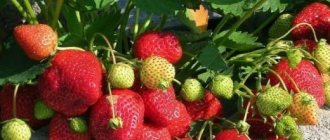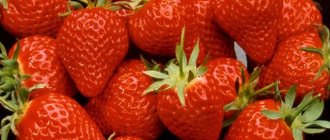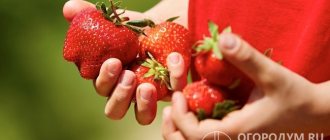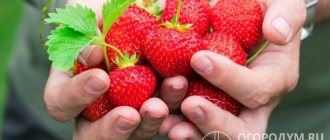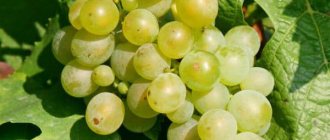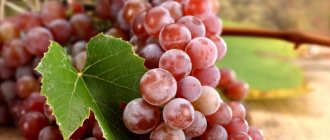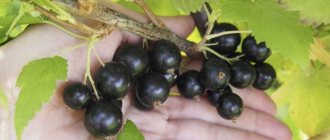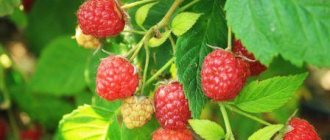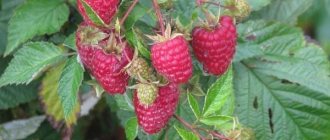Kimberly is a hybrid variety of garden strawberry that is very popular among home and commercial gardeners due to the high quality of the berries. The crop is distinguished by medium-early ripening, large fruit, rich taste and excellent appearance. However, it is demanding on care and weather conditions, which creates certain difficulties during its cultivation.
Botanical description of the variety
Brief botanical description of the Kimberly variety:
- Bushes. Powerful, compact, not thick. The mustache is thick and not numerous. But to increase productivity, even they need to be removed.
- Leaves. Large, concave, light green, glossy, jagged edges. The shape of the leaves is oval.
- Fruit. Sweet, large, glossy, with a caramel smell. There are almost no small berries. The pulp is dense, without voids. The shape is conical, the berry looks like a heart.
- Flowers. Large, white, bisexual. They have a lot of pollen - they pollinate quickly and easily.
The flower stalks are located low, almost close to the ground. If the berries touch the soil, the risk of powdery mildew increases.
Description and characteristics of strawberries
The culture belongs to the remontant varieties. This means that the plant produces fruit throughout the entire season when grown in open ground, and when cultivated in shelters or at home, all year round. Plants are medium-sized. They are bushes up to 30 cm high. The leaves are medium-sized and dark green. They have a round shape, with blunt teeth along the edges. The veins are pronounced and protruding. The petioles are of medium thickness and also have pubescence.
Flowering is abundant. The flowers themselves are large, with well-developed anthers. Male and female flowers are formed on the same bush. The pollen of this plant is of a special quality, due to which it not only pollinates itself, but is also a pollinator for other varieties. Peduncles are numerous, of medium height, located approximately at the level of the leaf blades.
The fruits of the plant are small, but in very large quantities. The size of one medium berry is only 15–20 g. The yield from one bush is 700–900 g. The shape of the fruit is wide-conical. The surface of ripe strawberries is painted bright red. The achenes are numerous and yellow in color. The pulp is moderately dense, the consistency is tender, juicy, and very aromatic. The taste is sweet with elegant sourness.
Regarding use, the fruits are universal. Well suited for fresh consumption, processing into jams, preserves, pastilles, juices, purees. But, due to the insufficiently dense structure of the pulp, they are not suitable for production for sale, because they cannot withstand transportation at all.
Important! The Ostara variety can be a pollinator for strawberry varieties with any ripening period, because
blooms several times per season.
Main characteristics of the Ostara variety:
- immunity to diseases and pests is average, it is not affected more often than other varieties, timely preventive treatment is highly desirable;
- winter hardiness - relatively high, in the middle zone it tolerates winter well even in periods with little snow, in the northern zone it needs shelter;
- heat resistance and drought resistance are high, but in particularly hot periods, without additional watering, the berries become even less dense, but acquire greater sweetness;
- demands on agricultural technology - undemanding, even a beginner can cope with its cultivation;
- soil quality - it bears fruit even on soils that are poor in nutrition, but if you follow the basic rules of agricultural technology, the yield increases by 2 times;
- demanding on soil moisture - the variety does not tolerate increased humidity, this is one of the strawberry crops that are better off without adding water than overwatering;
- The variety renewal period is every 1-2 years; this variety cannot tolerate a longer period, because it produces fruits throughout the entire season, which greatly depletes the plants.
One of the features of the variety under consideration is the ability to form fruits not only on peduncles, but also on unshortened tendrils.
You should not let plants reproduce on their own. The fact is that even smaller fruits form on the whiskers. If you leave the whiskers, the variety will degenerate faster, and as a result, after 1-2 years there will only be berries on the plot with a diameter of no more than 1 cm.
Qualities of Kimberley strawberries
Kimberly is a mid-early variety suitable for growing in open ground and under cover. Suitable for any region, including Siberia and the Urals. The variety is considered promising - it has high yields and is resistant to any unfavorable conditions.
Main agrotechnical indicators:
| Characteristics/parameters | Description/meaning |
| Fruiting | non-repairing variety – bears fruit once |
| Ripening time | last ten days of May |
| Average weight of berries | 20-35 g, maximum – 50 g |
| Productivity | 1-2 kg per bush, per 1 ha - up to 150 c |
| Taste | sweet, but not cloying |
| Aroma | smells like caramel |
| Disease resistance | medium (can be affected by anthracnose, as well as pests - slugs, weevils, etc.; resistant to gray rot, white and brown spot and powdery mildew) |
| Tasting score | 5 (this is the highest score) |
| Drought resistance | high, able to survive long droughts, recovers due to a powerful root system |
| Frost resistance | high, withstands frosts down to minus 18 °C |
Other features of the variety:
- The variety bears fruit once per season. With adequate nutrition, the berries do not shrink during the entire harvest - it lasts about three weeks.
- Kimberly is called strawberry only by established tradition; in fact, it is a garden strawberry.
- The variety is demanding of light. If there are few sunny days in the spring, the bushes grow poorly and bloom late, and the berries lose their sugar content.
- In the northern regions, the berries may not ripen during the short summer - the core and base remain white, they contain little sugar, and the taste is average.
- In the southern regions, the yield is negatively affected by the heat during the fruiting period - the berries overheat, the bushes grow slowly.
- The berries are distinguished by good transportability and retain their presentation for a long time.
- The fruits do not lose their shape during heat treatment and freezing.
Watch a video review of Kimberly variety strawberries below:
History of variety selection
Kimberly is a young hybrid of garden strawberries, obtained in Holland by crossing two well-known varieties - Chandler and Gorella. The crop was brought to Russia in 2008, at which time its variety testing and registration procedure began. The variety was included in the State Register in 2013 under the full name Vima Kimberly and classified as a garden strawberry.
In a short time, the berry became popular. Kimberly strawberries, according to reviews from gardeners in the CIS countries, are noticeably superior to the original varieties in many characteristics.
How to choose the right Kimberly seedlings?
In order for seedlings to safely survive the winter and bear fruit, they must initially be of high quality and completely healthy. Rules for choosing seedlings:
- Do not take seedlings at the market, from sellers you are unfamiliar with, or in places not intended for selling this product.
- When buying seedlings, pay attention to their appearance. The leaves should be uniform in color, without spots or other damage indicating a fungal infection.
- Pale, wrinkled or wilted leaves are a signal that the seedlings are infected with a serious disease. The plant will not only not grow and develop normally, but will also infect other strawberries on the site.
- Bare-rooted seedlings must have a fibrous root system at least 7 cm long.
- If seedlings are sold in containers or cups with their roots closed, they must fill the entire underground part.
- The roots should not be overdried - such a plant runs the risk of not taking root.
- Store seedlings purchased but not planted for several days by immersing the roots in water - this technique will not only prevent the plant from drying out, but will also facilitate rooting.
Rules for planting strawberry seedlings
The general rules for planting Luna strawberries coincide with the requirements for planting other varieties of late-ripening strawberries, however, certain nuances of the procedure still exist. For this reason, you should definitely take into account the most appropriate timing of planting activities, choose the right place to place the strawberries, and of course, strictly adhere to the technology of planting seedlings.
Timing and choice of landing site
The exact timing of planting a crop depends on several main factors: the climatic conditions of a particular region and the requirements of the plant being planted. In the case of late-ripening strawberries, most gardeners choose autumn planting (performed in September or early October), especially if the site is located in the south of Russia or in the central part of the country.
Important! If the groundwater comes too close to the surface of the earth, and you do not have an alternative option for choosing a site, then high embankments on the beds or laying a good drainage layer will help solve the problem. In the northern regions, spring planting of seedlings is allowed, but only after the threat of return frosts has passed
As for choosing a place for strawberries, the Luna variety does not have any special requirements, the main thing is that the area is not flooded with groundwater and is well warmed up by the sun’s rays
In the northern regions, spring planting of seedlings is allowed, but only after the threat of return frosts has passed. As for choosing a place for strawberries, the Luna variety does not have any special requirements, the main thing is that the area is not flooded with groundwater and is well warmed by the sun's rays.
The composition of the soil for plants can be anything, but the best fruiting is observed on light fertile substrates: sandy loam or sand. Peat and soddy-podzolic soils are not the most suitable solution for planting strawberries, since their fruiting in such conditions will not be as abundant.
Preparing the site and seedlings for planting
For spring planting, preparing beds for strawberries begins in the fall, while when performing the procedure in the fall, you can start organizing them 1–1.5 months before.
In any case, the algorithm for performing pre-landing actions will be as follows:
- Dig the entire area to the depth of a spade bayonet so that you can only slightly fluff up the soil before planting.
- Add organic or mineral fertilizer (for example, 5-6 liters of rotted manure per 1 m² of territory).
- If there are parasites in the soil or if crop diseases have been recorded in the past, it is worth additionally shedding the soil with a solution of potassium permanganate or a specially purchased disinfectant (one of the popular fungicidal or insecticidal compositions can be used).
- Lay out the area according to an appropriate planting pattern. When growing Luna strawberries, the optimal values will be 15–20 cm between adjacent plants in a row and 60–70 cm between rows with strawberries. The depth of planting of the rhizomes of young plants should not exceed 10–15 cm.
Preparing seedlings for planting is based on a thorough examination of the root system and aerial parts of young seedlings, removing dead roots and treating the remaining roots in a root formation stimulator (for example, “Kornevin”). In addition, if the length of the roots of the seedling exceeds 10–12 cm, then they are trimmed with scissors, but in no case are broken off by hand. This may cause the strawberries to stop growing.
Read more: proper planting of strawberries in spring.
The process of planting young seedlings
After successfully completing all preparatory activities, when the right moment arrives for planting strawberries on the site, you can proceed to the implementation of your plan, based on the following step-by-step plan:
- Gently fluff up the soil again and create holes for the purchased seedlings in the designated places (a hoe or a small spatula will help with this).
- Moisten the soil in the holes well and wait until the moisture is completely absorbed into the ground.
- Take the prepared seedling and, holding it strictly vertically, place it in the hole, carefully straightening the roots of the plant.
- Cover the rhizome with soil, but only so that there is no free space between the individual roots (the level of the root collar and the soil must be the same).
- Once again compact the soil around the stems of the seedlings and, after watering the soil abundantly, mulch it with a thin layer of straw or sawdust, which will retain moisture in the soil for a long time.
Does the variety have any disadvantages?
The Kimberly variety has been known to farmers and amateur gardeners for about 10 years. This strawberry has proven itself to be a reliable and productive variety, but it has some disadvantages:
- It bears fruit poorly in Kamchatka and the Northern Urals. In the northern regions, the variety does not reveal its taste.
- Fruiting is not uniform, it lasts for several weeks.
- In regions with harsh winters, it freezes and then has difficulty recovering.
- Loves warmth. In cold years it grows poorly and loses productivity.
- It bears fruit poorly in regions with hot and dry summers. Here, Kimberly seedlings take root worse than many industrial varieties.
- Demanding on hydration. In hot summers, berries that are not provided with proper watering soften and become “boiled.”
- Kimberly is an intensively cultivated variety - it needs regular feeding and watering.
Peculiarities
- Due to its high frost resistance, this variety is grown in almost any region of the Russian Federation. But, nevertheless, in the northern regions the plant requires an additional “blanket” for the winter.
- The main feature of the berry is its taste. It is very reminiscent of caramel.
- This is one of the most popular varieties in the commercial business.
- Fruit ripening occurs at the beginning of June. However, if you use the technique of growing bushes in tunnels, then you can shorten the growing season and get the coveted berry in mid-May.
Dates and place of landing
There are two options for planting Kimberly seedlings:
- In spring - in the first ten days of May.
- In autumn - in August-September.
These are the dates for the middle zone. In regions with a milder climate, seedlings are planted mainly in the fall - at the end of September or even at the beginning of October. In autumn the weather is milder and more favorable for young plants. In the northern regions, it is better to plant in the spring, so as not to expose young plants to low temperatures. Read here how to plant strawberries correctly in spring.
Kimberly's berries taste much better if they are grown in open ground rather than in a greenhouse.
How to choose a site for planting:
- The variety is very demanding on lighting - the sunniest areas are chosen for it.
- The site must be protected from gusty winds.
- It is desirable to slope the beds in a southerly direction.
- The soils are fertile and well permeable to moisture. It is desirable that the soil contains peat or sand.
- The area must be cleared of plant debris, including roots. If necessary, the soil is disinfected - this is done in advance so that toxic substances do not destroy the seedlings.
- Undesirable predecessors are tomatoes, peppers, eggplants and other nightshades. Strawberries are planted after legumes, herbs, carrots, radishes, garlic, and onions.
- Kimberly's neighbors should not have plants that attract the same pests as garden strawberries.
- The presence of marigolds, calendula, tansy, nasturtium, parsley, lemon balm, garlic, cilantro, and fennel is desirable on the site.
- You cannot grow strawberries for more than 4 years in one area - the soil is depleted, but a lot of parasites, bacteria and viruses accumulate in it.
Suitable region and climate
Based on reviews from summer residents, Dutch Kimberley strawberries are grown in many regions. But it is worth noting that the culture gives the most optimal results in areas with a mild climate. According to variety tests, Kimberly was recommended to be grown in the cities of the Central and Central Black Earth regions. It is in the Voronezh, Kursk, Belgorod, Moscow, Ryazan, Tula, Lipetsk, Vladimir, Orel, and Tambov regions that strawberry fruits reach their maximum size and sweetness.
Ripe strawberries are colored intensely carrot-red.
How to plant strawberries?
Kimberly can be propagated by any of the existing methods - vegetatively, by seeds or by dividing the bush. The most reliable way to obtain varietal seedlings is vegetative propagation. The bushes produce a few tendrils, and if sparse planting is used, they can be rooted between the rows - without transplanting the plant to a new bed.
Seeds
The procedure for growing seedlings from seeds:
- Shortly before the end of winter, seeds are placed in a container with universal soil, previously moistened with a spray bottle. They are placed directly on the ground without pressing.
- Cover the container with the seeds with film.
- The film is removed daily to ventilate the planting.
- The soil is watered as needed.
- When sprouts appear, the film is removed.
- When the plants have several leaves, the seedlings are taken out for hardening and then planted in a permanent place.
This propagation option is not popular among gardeners; firstly, it is labor-intensive, and secondly, when planting seeds there is a risk of losing some varietal qualities.
Usami
This is the most popular method of propagation among summer residents. Breeding order:
- For propagation by mustaches, two-year-old plants are chosen. Usually the mustache is removed for good fruiting. The mustaches on the selected plants are not torn off - they are left to grow.
- When rosettes appear, their roots are buried a little into the ground. The soil around the rosette bushes is watered.
- The rosettes can be transplanted into containers so that they grow a little, and then transplanted to a new location.
Dividing the bush
The propagation method by dividing the bush is slightly less popular than by mustache. The procedure is as follows:
- Choose a powerful bush. Dig it up and divide the root into two or more parts.
- It is desirable that each separated part has a heart. Then the bushes are planted in a permanent place.
Seedlings
The easiest way of propagation is to plant ready-made seedlings purchased at a specialized point, store or nursery. Seedlings are sold in two types:
- With bare roots , it is advisable to immediately plant it in the ground. If this does not work, the roots are immersed in water. Then, before planting, the roots are trimmed to a length of 7-10 cm.
- With closed roots. It’s easy to plant such seedlings - you just need to water them and then transfer them, along with a lump of earth, into the planting hole.
How to properly store the harvest?
Since the fruiting period of Kimberly garden strawberries is quite short, you want to keep the fragrant fruits fresh for as long as possible. But before you put them in storage, you need to follow a few rules:
- The fruits must be picked together with the stalk and tail;
- pick only ripe garden strawberries;
- It is recommended to put the fruits in small baskets so that they do not get wrinkled.
Several methods can be used to store crops:
- refrigerator - here the fruits are stored for 2-3 days;
- freezer - can be stored for up to a year;
- fruits with sugar - stored for up to a year;
- in the form of preparations (jam, compote) - up to a year.
Of all the above methods, it is best to store garden strawberries frozen.
Caring for Kimberly
The Kimberly variety does not require anything special - only standard care. The main thing is not to forget about the low frost resistance of the variety, and to insulate the plantings for the winter.
Watering, weeding, loosening
Immediately after planting, the seedlings are watered daily. After the water is absorbed, the soil is carefully loosened so as not to touch the roots. Do not allow the soil to dry out or crack. During loosening, weeds are removed along the way - they are easier to remove from moist soil. With age, the number of waterings decreases.
Kimberly loves moisture - the soil should be moistened 30 cm deep. In rainy summers, watering is not needed; in hot weather, the frequency of watering increases - the bushes are watered every other day. Watering rate is 2-3 liters per plant. The best way to water strawberries is drip irrigation.
Top dressing
Spring begins with the application of nitrogen fertilizers. They are applied immediately after removing the cover - they cut off the dried foliage, loosen the soil, having previously scattered nitrogenous fertilizer. During the season, strawberries are fed three times.
Timing of application and composition of fertilizers:
| Application period | Composition and doses of fertilizers |
| Early spring | Fertilize with mullein/bird droppings infusion (1:10/1:20), horse extract solution (per 10 l - 50 g), urea or ammonium nitrate (per 10 - 30 g). Per bush - 0.5 liters of liquid solution. We recommend that you additionally read our full article on spring feeding of strawberries. |
| Bud formation | Feed with wood ash - 1-2 tbsp. l. under one bush. Or a purchased mixture containing microelements. |
| Autumn – end of the growing season | Superphosphate is poured into the grooves (depth 15 cm) made along the rows - 1 tbsp. l. by 1 p.m. |
To improve productivity, spraying is recommended:
- During flowering - with a solution of boric acid (per 10 l - 1 g).
- In August, during the laying of next year's flower buds - with a solution of urea (per 10 l - 15 g).
Do you need mulch?
Mulching is not mandatory, but it has an extremely positive effect on the condition of the plantings and saves farmers from unnecessary labor. This agrotechnical event solves two problems at once:
- prevents weed growth;
- retains moisture in the soil.
It is best to start mulching the soil during active flowering. Various materials are suitable as mulch - the soil is sprinkled with straw, dry grass, fallen leaves. On alkaline soils, it is also allowed to use sawdust and pine needles - they increase the acidity of the soil.
Before mulching, straw and grass are dried in the sun to kill insects and weeds.
Trimming
If seedlings are planted before winter, all foliage is removed. Similar pruning is carried out annually at the end of the growing season - just before frost. Thanks to pruning, the plant increases its strength and its future productivity increases. To enhance the growth of shoots, the bushes are pruned more strongly - only the stems are left.
Not only leaves and shoots are trimmed, but also mustaches - during the growing season. This is done to direct the vital juices of the plant to the berries. If the mustache is not trimmed, there will be few berries. And their size will be smaller than usual.
The best option is to divide the bushes into two groups: for harvest and for propagation. Or just spend one year on breeding - do not trim the whiskers, sacrificing a high yield.
Wintering
You can refuse to insulate Kimberley in one case - if you are confident that there will be a large snow cover. Since there can be no guarantees in this regard, strawberry plantings must be covered.
Agrofibre, pine branches or special covering material are used as insulation. Straw and fallen leaves should not be used - they are full of larvae and rodents, and such insulation will cause too much harm. You cannot cover the plantings with dark film or cloth - the plants will rot under them.
The best option for insulation is the construction of an arch with subsequent tension of the covering material. Then air remains between the plants and the shelter - this solution prevents freezing.
Landing in the ground
The plot for Kimberley strawberries must meet special requirements: flat terrain with a slope to the southwest, good access to the sun, satisfactory protection from the wind, light, sufficiently fertilized soil, absence of weeds. The bed needs to be dug up and humus added 5-10 kg for every 1 sq. m. The holes should be thoroughly watered. When planting a bush, cut off all the leaves, leaving the central leaf with roots. Maintain a distance of 70-90 cm between bushes. Make sure that the rosette heart is not buried or raised too high.
Strawberries "Kimberly" - one of the best varieties
Diseases and pests of the Kimberly variety
It is much more profitable to spray strawberries without waiting for signs of infection - if the plants begin to get sick, they can be cured, in most cases, but yield losses are inevitable. An important advantage of Kimberly is its resistance to powdery mildew. This strawberry, compared to other varieties, suffers from this serious disease.
The main pests of Kimberley are strawberry mites, aphids, nematodes, and strawberry weevils. Bushes affected by nematodes are almost impossible to save - the diseased plant is pulled out and destroyed.
Pest and disease control measures:
- Spraying with broad-spectrum insecticides during leaf formation. Usually they use Karbofos - 60 g are dissolved in a bucket, or Aktaru - 2-3 g. The drugs are effective for 2 weeks, then the treatment is repeated. These drugs destroy all pests - aphids, weevils, etc.
- According to a similar scheme, plants are treated with drugs against fungal diseases - on young foliage, and then after 2 weeks. The plantings are sprayed with systemic fungicides - Bordeaux mixture, Skor, HOM, Ridomil.
Preparations - insecticides and fungicides - are changed annually so that insects and fungi do not acquire immunity.
It is especially important to prevent gray rot:
- Plant garlic between rows.
- Trim dry leaves in a timely manner.
- Do not allow the soil to become waterlogged.
- Remove weeds promptly.
- Spray with Topaz before flowering.
Other ways to control pests and diseases:
- Spraying with iodine solution - take 10 ml of iodine per 100 ml of water.
- Dandelion infusion helps fight pests - place 0.5 kg of the plant in a bucket of warm water.
- You can use garlic infusion. Several ground heads are infused in 3 liters of water for a week.
Advantages and disadvantages
Among the advantages of the variety are:
- frost resistance;
- drought tolerance;
- rapid adaptation to climate change;
- high resistance to diseases;
- abundant fruiting, large beautiful berries;
- early harvest period;
- transportability - the berries retain their presentation for a long time.
The variety has few disadvantages, but they still exist:
- demanding of sunlight - berries grown in a greenhouse lose their taste;
- dependence of yield and berry size on environmental conditions;
- Sweet early fruits attract pests.
Reference. Kimberley strawberries contain vitamin C and folic acid. Berry infusion is a powerful diuretic and anti-inflammatory agent.
Reviews about the variety
★★★★★
Nikolay E., Nevinnomyssk. The variety is excellent - productive and tasty.
And the berries are large. But there is a peculiarity - there are not many ripe berries on the bush at the same time. They sing gradually. And if you pick the berries all the time, they don’t get smaller - the first and last fruits are the same size. ★★★★★
Alexey I., Chelyabinsk region. In our conditions, the berries grow excellently - of course, we insulate them for the winter.
The berries ripen at the end of June, they are not particularly sweet - they don’t see much sun. Taste 4 points. Not a lot of whiskers are formed, but there is enough for reproduction. The Kimberly variety has so many advantages that it simply could not help but interest gardeners. By following simple agricultural techniques, it is possible to achieve high yields even in harsh climates. A little effort, and a generous harvest of strawberries with a caramel aroma is guaranteed.
0
0
Copy link
Growing and care
In order for Kimberly variety strawberries to please you with large, tasty fruits and a good harvest, you must follow certain agricultural practices, taking into account the characteristics of the crop.
Watering
Adult plants are watered regularly when there is a lack of natural precipitation. Kimberly tolerates drought very poorly, the berries become smaller and the ovaries fall off. Therefore, the optimal solution is to organize drip irrigation.
In hot summers, you need to pour at least 2-3 liters per bush. every 3-4 days.
Loosening, weed control
Timely removal of soil crust and weed control are included in a mandatory set of agrotechnical practices. Good air exchange in the soil has a beneficial effect on the process of absorption of nutrients by the plant. Weeds have a depressing effect on strawberries, block the sun and deplete the soil.
Gardeners resort to techniques such as mulching the soil with hay and conifer needles to prevent weeds from growing and retain moisture in the soil. When using organic mulch, you need to take into account that as it decomposes, it will bind nitrogen and return it to the soil only at the end of the process. Therefore, immediately after mulching, nitrogen fertilizing is given; for example, you can sprinkle the mulch with a solution of mullein (1:10) or bird droppings (1:20).
Removing a mustache
When growing Kimberly, you need to decide on the specimens that will be used for reproduction. The plant does not produce many whiskers. They grow slowly, but they must be removed from fruiting bushes in a timely manner. Otherwise, they will take away strength, the fruits will not be as large, and the yield will decrease. It is better to select several of the strongest mother bushes on the site, remove all flower stalks from them and try to get as many first-order rosettes as possible, applying fertilizers in a timely manner and watering the mother plant.
Top dressing
Kimberly is fed at least four times:
- at the beginning of spring;
- before flowering begins;
- during the period of fruit set;
- at the end of the harvest.
The best fertilizers will be organic and mineral mixtures. Strawberries need mineral fertilizers such as nitrogen, potassium and phosphorus. In spring, the emphasis should be on nitrogen, because it is necessary for the plant to grow green mass. Rotted manure (1 m2 bucket) and urea (according to instructions) are suitable. During flowering, more potassium fertilizers are needed. An excellent option is to use ash (a glass per m2).
Pest and disease control
When growing Kimberly, you should carry out prevention against pests and diseases, without waiting for infection. For nematodes, strawberry mites and weevils, use Aktara (2 g per 10 l).
Instead of chemicals, you can spray the bushes with a solution of ammonia (15 ml per bucket) in early spring.
An effective remedy against pest invasion is garlic tincture. 3-5 heads are filled with 3 liters. water and leave for two weeks.
For fungal diseases, fungicides and Bordeaux mixture are used. When treating in early spring, it is necessary to cover not only the bushes, but also the ground around them.
Strawberry berry – review
Strawberry variety Kimberly
This year I decided to update my strawberry varieties (garden strawberries, if I'm a botanist). I read reviews on the Internet, but almost all Dutch varieties were good, differing only in ripening time and berry shape. Therefore, I did it simpler; on a Saturday spring day I went to the fair and bought several varieties of garden strawberries available. Among these varieties I came across Kimberly.
At first, all the bushes simply increased their green mass, then fruit bearings appeared. In the description, the variety is stated as early, but for me it has ripened on par with other varieties that are not considered early. But I make allowance for the first year and the fact that summer in the Urals this year is not so hot. Throughout May there was drought and heat of +30. and in June there is constant rain and cold. In general, we should be happy that in the first year at least some berries ripened. Despite all the weather disasters, the berries are not watery, but very tasty! Another advantage is that they bear strong fruit; the berries do not lie on the ground, do not get dirty or spoil.
The berries of the Kimberly variety are beautiful, glossy, and evenly shaped. I didn’t manage to photograph the harvest on the bush (the smart idea came after the harvest), but for the strawberries of the 1st year of planting, the harvest made me happy. Each bush produced 4-5 berries, a few more green berries. I think this is a great result! Next year I'm expecting a mega harvest.
The weight of 1 berry is on average 20-25 grams, weighty and dense. 1 ruble coin for scale. There is no need to be afraid that by the time the harvest reaches the house from the dacha, it will turn into mush. But at the same time, the inside of the berries is very soft, juicy, and melts in your mouth. The aroma is incomparable, rich strawberry and fresh. The taste is sweetish, but there is a noticeable sourness, I think this is due to the cool summer and not generous with sunshine.
I liked the Kimberly variety, and I confidently recommend it to fellow gardeners. I won’t copy the description of the variety from the Internet, it’s not difficult to find, but they write that the variety is resistant to diseases and our cold weather. I would like to believe this, because... I plan to increase the number of Kimberly bushes with mustaches.
I didn’t do any canning, because... There were only 10 bushes, all the berries were eaten alive.
P.S. Sorry for the signed photos, but some unscrupulous online stores like to take my photos without asking, erasing the standard signatures from irecommend. I always try to make photos bright and beautiful, so I don’t want to see them on the website of some store.
Origin of culture
Vima Kimberly (Vima Kimberly) belongs to the large-fruited, non-remontant varieties of garden strawberries of early ripening. This form was bred in 1995 by breeders of the famous Dutch agrotechnical company Vissers Aardbeiplanten. The company became the originator (copyright holder) of the variety.
In the photo: one of Kimberly’s parent varieties is the large-fruited “American” Chandler. Photo: ua.all.biz
To obtain Kimberly, scientists crossed two popular early-ripening strawberry varieties using cross-pollination:
- American Chandler (Chandler), characterized by high yield and large berries;
- English Gorella (Gorella), unpretentious and disease resistant.
As a result, the breeders received an early-ripening form of strawberry, suitable for cultivation both in greenhouse conditions and in open ground.
In 2008, Kimberly entered Russia for varietal testing. In 20013, she successfully passed them. The form received variety status and was registered in the Russian State Register of Breeding Achievements.
In the south of Russia, Kimberley is grown in open ground. Photo: agronomu.com
Officially, the Kimberley strawberry variety is zoned in the following regions of Russia:
- North Caucasus;
- Central Black Earth;
- Volgo-Vyatka;
- Central;
- Stavropol and Krasnodar territories.
What strawberry lovers say
Some reviews from gardeners growing the Kimberly variety:
Elena Velyaminova, Bratsk:
“Everyone loves strawberries here, from young to old. I purchased the “Kimberly” variety at the fair. I'm very pleased. The characteristics clearly correspond to the description, the care is traditional (just be careful about watering). The berries are large, beautiful, very tasty and aromatic. It’s a real pleasure to eat these strawberries!”
Source fermilon.ru
Inna, 32 years old:
“The Kimberly strawberry variety literally captivated me. And the reason is that after planting seedlings, they grow and develop very quickly. The first harvest can be obtained already in the 2nd year. The berries are incredibly juicy and sweet. You can make quite tasty jam from them. The main thing is that the bushes grow in a well-lit place. If there is little sunlight, the plant’s development will stop and the fruits will begin to rot.”
Source gidfermer.com
Margarita Zemtsova, Novosibirsk:
“It’s difficult to find time to work at the dacha. But I rest in the Kimberley strawberry beds. Such a grateful variety that any care is immediately returned with excellent berries. There are not many bushes at the dacha, but the yield is high, there are enough fruits to harvest and enjoy fresh.”
Source fermilon.ru
